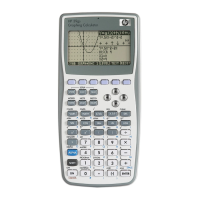Using mathematical functions 13-13
RANDOM Random number (between zero and 1). Produced by a
pseudo-random number sequence. The algorithm used in
the RANDOM function uses a seed number to begin its
sequence. To ensure that two calculators must produce
different results for the RANDOM function, use the
RANDSEED function to seed different starting values
before using RANDOM to produce the numbers.
RANDOM
HINT
The setting of Time will be different for each calculator, so
using RANDSEED(Time) is guaranteed to produce a set of
numbers which are as close to random as possible. You
can set the seed using the command RANDSEED.
UTPC Upper-Tail Chi-Squared Probability given degrees of
freedom, evaluated at value. Returns the probability that
a χ
2
random variable is greater than value.
UTPC(degrees, value)
UTPF Upper-Tail Snedecor’s F Probability given numerator
degrees of freedom and denominator degrees of freedom
(of the F distribution), evaluated at value. Returns the
probability that a Snedecor's F random variable is
greater than value.
UTPF(numerator, denominator, value)
UTPN Upper-Tail Normal Probability given mean and variance,
evaluated at value. Returns the probability that a normal
random variable is greater than value for a normal
distribution. Note: The variance is the square of the
standard deviation.
UTPN(mean, variance, value)
UTPT Upper-Tail Student’s t-Probability given degrees of
freedom, evaluated at value. Returns the probability that
the Student's t- random variable is greater than value.
UTPT(degrees, value)
Real-number functions
Some real-number functions can also take complex
arguments.
CEILING Smallest integer greater than or equal to value.
CEILING(value)
HP 39gs English.book Page 13 Wednesday, December 7, 2005 11:24 PM

